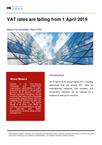
March 2019 - VAT rates are falling from 1 April 2019
On 5th March 2019, China Premier, Mr. Li Keqiang announced that the current VAT rates for manufacturing industries and transport and construction industries will be reduced as a measure to beef up the economy.
The new VAT rates:
The actual implementation date will be 1st April 2019.
When the new VAT rates are implemented, they shall be changed to 13%, 9%, 6% and 0% accordingly. The reductions are as follow:
Scope | Current VAT rate | New VAT rate |
Sales or importation of tangible goods, provision of labor services and leasing of tangible personal property | 16% | 13% |
Provision of transport, postal, basic telecommunications, construction, and real property leasing services, sales and transfer of real property, and land use right, and sales or importation of 23 kinds of goods listed in the Provisional VAT Implementation Rules | 10% | 9% |
Provision of financial services, modern services(including R&D, IT, cultural creativity, logistics supporting, consulting, radio, film and television services, business supporting and others), Daily life services (including cultural and sports, education and medical , tourism and entertainment, catering and accommodation. | 6% | 6% |
Exportation of tangible goods, services, and transfer of intangible assets outside China | 0% | 0% |
Mazars’ comments
Owing to the changes in VAT rates, taxpayers should pay attention to the following risks:
1. Applicability of new and old VAT rates
Taxpayer should pay attention to when the VAT liabilities arise in this transitional period. If the tax liabilities arise before the implementation date of the new VAT rates, old VAT shall prevail. On the other hand, if the VAT tax liabilities arise after the implementation date, new VAT shall be applicable. This transition could trigger un-warranted implications.
It is announced that the implementation date is 1st April 2019. If a taxpayer entered into an agreement with a customer in February 2019, under which the taxpayer will be entitled to recognize the sales after it has delivered the goods to the customer. The taxpayer delivers the goods to the customer in March and issues VAT special invoice with the new VAT rate of 13% in April.
According to the Provisional VAT Implementation Rules, VAT liabilities shall arise at the earlier of either the goods are delivered or the issuance of VAT invoices. As such, the VAT liabilities shall arise in March when the goods are delivered. Therefore, the applicable VAT rate should be 16% instead of 13%. This taxpayer would be subject to the risk of under-reporting VAT in that month, i.e., March.
We therefore advise taxpayers that they should pay attention to the applicability of new and old VAT rates during this transitional period in order to avoid possible late payment surcharges thus arisen.
2. Review the contracts already concluded
The forthcoming tax rates may lead to loss in tax in actual implementation
For example, if a taxpayer enters into a contract to buy goods at a tax inclusive price of RMB 1.16 million in March 2019. In May, it receives a VAT special invoice with the new VAT rate. It would result in lower input VAT of RMB 0.133 million (instead of 0.16 million under the old VAT rate) and higher purchase price. Therefore we advise taxpayers to review the existing contracts to see whether it would result in higher tax liabilities due to the changes in VAT rates and approach the contract parties for amendments, if necessary.
Download the document to find more details.





